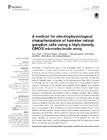A method for electrophysiological characterization of hamster retinal ganglion cells using a high-density CMOS microelectrode array
dc.contributor.author
Jones, Ian L.
dc.contributor.author
Russell, Thomas L.
dc.contributor.author
Farrow, Karl
dc.contributor.author
Fiscella, Michele
dc.contributor.author
Franke, Felix
dc.contributor.author
Müller, Jan
dc.contributor.author
Jäckel, David
dc.contributor.author
Hierlemann, Andreas
dc.date.accessioned
2019-05-29T12:08:38Z
dc.date.available
2017-06-11T20:12:56Z
dc.date.available
2019-05-29T12:08:38Z
dc.date.issued
2015-10-13
dc.identifier.issn
1662-453X
dc.identifier.issn
1662-4548
dc.identifier.other
10.3389/fnins.2015.00360
en_US
dc.identifier.uri
http://hdl.handle.net/20.500.11850/105628
dc.identifier.doi
10.3929/ethz-b-000105628
dc.description.abstract
Knowledge of neuronal cell types in the mammalian retina is important for the understanding of human retinal disease and the advancement of sight-restoring technology, such as retinal prosthetic devices. A somewhat less utilized animal model for retinal research is the hamster, which has a visual system that is characterized by an area centralis and a wide visual field with a broad binocular component. The hamster retina is optimally suited for recording on the microelectrode array (MEA), because it intrinsically lies flat on the MEA surface and yields robust, large-amplitude signals. However, information in the literature about hamster retinal ganglion cell functional types is scarce. The goal of our work is to develop a method featuring a high-density (HD) complementary metal-oxide-semiconductor (CMOS) MEA technology along with a sequence of standardized visual stimuli in order to categorize ganglion cells in isolated Syrian Hamster (Mesocricetus auratus) retina. Since the HD-MEA is capable of recording at a higher spatial resolution than most MEA systems (17.5 μm electrode pitch), we were able to record from a large proportion of RGCs within a selected region. Secondly, we chose our stimuli so that they could be run during the experiment without intervention or computation steps. The visual stimulus set was designed to activate the receptive fields of most ganglion cells in parallel and to incorporate various visual features to which different cell types respond uniquely. Based on the ganglion cell responses, basic cell properties were determined: direction selectivity, speed tuning, width tuning, transience, and latency. These properties were clustered to identify ganglion cell types in the hamster retina. Ultimately, we recorded up to a cell density of 2780 cells/mm2 at 2 mm (42°) from the optic nerve head. Using five parameters extracted from the responses to visual stimuli, we obtained seven ganglion cell types.
en_US
dc.format
application/pdf
en_US
dc.language.iso
en
en_US
dc.publisher
Frontiers Media
dc.rights.uri
http://creativecommons.org/licenses/by/4.0/
dc.subject
Retinal ganglion cells
en_US
dc.subject
RGC
en_US
dc.subject
MEA
en_US
dc.subject
CMOS
en_US
dc.subject
Visual stimulation
en_US
dc.subject
Cell classification
en_US
dc.subject
Retina
en_US
dc.subject
Sensory encoding
en_US
dc.title
A method for electrophysiological characterization of hamster retinal ganglion cells using a high-density CMOS microelectrode array
en_US
dc.type
Journal Article
dc.rights.license
Creative Commons Attribution 4.0 International
ethz.journal.title
Frontiers in Neuroscience
ethz.journal.volume
9
en_US
ethz.journal.abbreviated
Front Neurosci
ethz.pages.start
360
en_US
ethz.size
16 p.
en_US
ethz.version.deposit
publishedVersion
en_US
ethz.grant
Seamless Integration of Neurons with CMOS Microelectronics
en_US
ethz.grant
Image processing by mosaics of retinal cells
en_US
ethz.identifier.wos
ethz.identifier.scopus
ethz.identifier.nebis
009497874
ethz.publication.place
Lausanne
ethz.publication.status
published
en_US
ethz.leitzahl
ETH Zürich::00002 - ETH Zürich::00012 - Lehre und Forschung::00007 - Departemente::02060 - Dep. Biosysteme / Dep. of Biosystems Science and Eng.::03684 - Hierlemann, Andreas / Hierlemann, Andreas
en_US
ethz.leitzahl.certified
ETH Zürich::00002 - ETH Zürich::00012 - Lehre und Forschung::00007 - Departemente::02060 - Dep. Biosysteme / Dep. of Biosystems Science and Eng.::03684 - Hierlemann, Andreas / Hierlemann, Andreas
ethz.grant.agreementno
267351
ethz.grant.agreementno
141801
ethz.grant.fundername
EC
ethz.grant.fundername
SNF
ethz.grant.funderDoi
10.13039/501100000780
ethz.grant.funderDoi
10.13039/501100001711
ethz.grant.program
FP7
ethz.grant.program
Sinergia
ethz.date.deposited
2017-06-11T20:13:08Z
ethz.source
ECIT
ethz.identifier.importid
imp5936539670ebb46868
ethz.ecitpid
pub:165394
ethz.eth
yes
en_US
ethz.availability
Open access
en_US
ethz.rosetta.installDate
2017-07-20T14:27:25Z
ethz.rosetta.lastUpdated
2024-02-02T08:10:28Z
ethz.rosetta.versionExported
true
ethz.COinS
ctx_ver=Z39.88-2004&rft_val_fmt=info:ofi/fmt:kev:mtx:journal&rft.atitle=A%20method%20for%20electrophysiological%20characterization%20of%20hamster%20retinal%20ganglion%20cells%20using%20a%20high-density%20CMOS%20microelectrode%20array&rft.jtitle=Frontiers%20in%20Neuroscience&rft.date=2015-10-13&rft.volume=9&rft.spage=360&rft.issn=1662-453X&1662-4548&rft.au=Jones,%20Ian%20L.&Russell,%20Thomas%20L.&Farrow,%20Karl&Fiscella,%20Michele&Franke,%20Felix&rft.genre=article&rft_id=info:doi/10.3389/fnins.2015.00360&
Files in this item
Publication type
-
Journal Article [128830]

